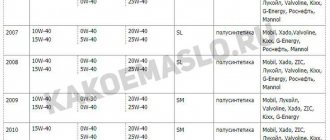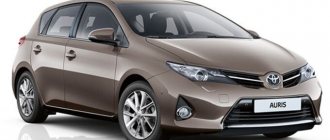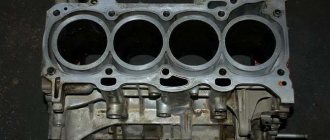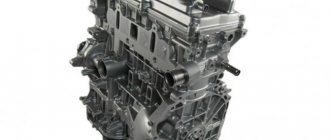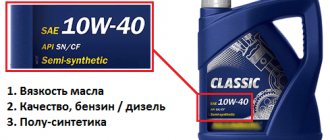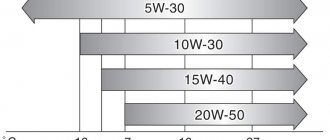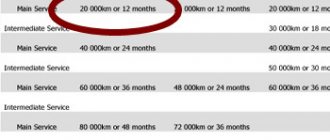In 2003, Toyota released the second-generation Prius passenger car (translated from Latin as the first, original) with a hybrid power unit. This installation allows the vehicle to move through the simultaneous use of a gasoline and electric motor. This led to a reduction in fuel consumption and emissions of harmful gases into the atmosphere. For improving the environmental friendliness of the power unit, Toyota Corporation received awards from UNEP and the UN. At the same time, the Prius model has repeatedly received the title of car of the year in Japan, North America and Europe.
Prius XW20
The second generation Toyota Prius in the NHW20 body was produced until 2009. This model replaced the first generation sedan version and was produced as a hatchback. The overall dimensions were increased, and the streamlining of the car was improved.
Body and interior
Salon of the Prius XW20
Despite the transition from a sedan to a hatchback, the Toyota Prius in the 20 body retained the design features of the first generation model. This was manifested in the design of the front of the car - inclined headlights and a short hood made of aluminum. By giving the body a teardrop-like profile, it was possible to achieve improved aerodynamics. The following factors contributed to this:
- presence of a spoiler on the rear window;
- rear bumper shaped like a racing car diffuser;
- almost flat bottom.
Second row Prius XW20
The use of high-strength steel made it possible to obtain the required body rigidity, as well as reduce its total weight. Even the battery housing was used to enhance the strength of the rear part of the body. At the same time, the trunk lid was made of aluminum.
The interior of the Toyota Prius II was distinguished by a high driving position and an oval steering wheel with buttons for controlling the telephone, multimedia system and ventilation. This design of the steering wheel and seats contributed to excellent visibility and free entry or exit for the driver. To use the navigation system and control the operating parameters of the hybrid engine, a seven-inch touch screen was provided.
Prius XW20 trunk
Electronic control of the transmission operating modes was carried out using a unit mounted on the console near the steering wheel. In its functionality, it resembled the lever of a computer joystick. With its help, it was possible to use the standard automatic transmission positions (R, N, D), as well as the Brake mode (B), to turn on the recovery system. It works identically to the process of engine braking when engaging a lower gear on a manual transmission.
To start the motor, a special Power button was used. It was located on the front console. In this case, it was necessary to insert the electronic key into the corresponding slot near the steering wheel. The ignition switch itself was missing.
Trunk with second row folded
When reviewing the updated version of the 2005 Toyota Prius, some visual changes can be highlighted. Among them:
- chrome strip on the radiator grille;
- "Hybrid" lettering on the front fenders;
- the size of the rear seat has increased;
- new finishing materials were used for the interior;
- The headlights have been slightly modified.
Exterior of Toyota Prius PHV
The updated exterior of the Toyota Prius PHV is full of futurism and bold design solutions. A beveled radiator grille is installed at the front.
Toyota Prius PHV Front Bumper
Below is a large bumper with air intakes. The head optics are represented by LED lights with a “predatory squint”. LED headlight units are located on the front fenders.
Toyota Prius PHV side view right
The profile has become more streamlined and sporty. The concave glass of the luggage compartment lid continues with a small spoiler. By the way, the luggage door is now made of lightweight and durable carbon fiber.
Rear optics of a complex shape are installed on the body, but its line continues along the entire border of the upper part of the lid. It looks impressive and attractive.
Toyota Prius PHV side rear view
Back view
Rear lights Toyota Prius PHV
Nameplate with car model
Toyota Prius PHV has the following overall body dimensions: length – 4.645 m, width – 1.760 m, height – 1.470 m.
Hybrid powertrain
For the second generation Toyota Prius, hybrid installations were used using the THS II system. This made it possible to double the voltage level, which contributed to a longer period of operation of the electric motor. As a result, a significant reduction in fuel consumption of the Toyota Prius 20.
Under the hood of the Prius XW20
Thanks to the use of new technologies, the function of driving the car exclusively on electric power has appeared. This was ensured by a high-voltage battery.
A planetary gearbox was used for communication between the elements of the hybrid. The technical characteristics of the motors used in the hybrid installation will be discussed below.
1NZ-FXE
The 1NZ-FXE engine operates on the Atkinson cycle. This internal combustion engine model has never been used as a separate motor. The 1NZ line began to be produced back in 1999, and the 1NZ-FXE began to be installed on the Toyota Prius in 2000.
The first, unmodified version of the unit had 76 hp, and after modifications in 2006, 74 “power” remained in the engine, which made it possible to achieve optimal fuel consumption. The power was reduced on purpose, primarily for the sake of new environmental standards.
| 1NZ-FXE | |
| Volume, cm3 | 1496 |
| Power, hp | 58-78 |
| Consumption, l/100 km | 2.9-5.9 |
| Ø cylinder, mm | 75 |
| SS | 13.04.2019 |
| HP, mm | 84.7-85 |
| Models | Aqua; Corolla (Axio, Fielder); Prius (C); Probox; Sienta; Succeed; Vitz |
| Resource, thousand km | 200+ |
Among the advantages of the 1NZ-FXE installation, one can note its high reliability, of course, within the service life. Another advantage is the stable operation of electrical systems.
Disadvantages, cons of the Prius 20
During the operation of the second generation Toyota Prius, the following problems were identified:
Prius XW20
- Increased oil consumption, which becomes noticeable after 150,000 km. The cause of this problem is worn valve stem seals and clogged oil scraper rings;
- Low ground clearance leads to difficulties when driving on poor quality roads, as well as when parking. Damage to bumpers, underbody protection or crankcase of the power unit often occurs;
- Failure of the inverter cooling system pump at approximately eighty thousand kilometers. The reason is the poor quality of the bearings;
- Low level of noise insulation, clearly manifested when the car is moving at a speed of more than one hundred km/h;
- Weak heating stove in the cabin;
- When the car has driven 150,000 km, steering rack malfunctions may occur. They manifest themselves as failure of the electric amplifier or wear of the worm gear inside the rack;
- Over one hundred thousand kilometers, problems are observed with the anthers and the CV joints themselves. More often, the outer CV joint breaks, which is accompanied by a crunching sound from the side of the turned wheel as it rotates;
- Short service life of wheel bearings, limited to 50 thousand km;
- In rainy weather, unstable operation of the electrical part is observed.
Prius XW20 rear view
Some disadvantages of the 2007 Toyota Prius also stand out:
- the quiet operation of the power unit is accompanied by danger for passers-by who may not react in time to an approaching car;
- the passage of moisture through the rubber seal of the luggage compartment contributes to freezing of the trunk lid at subzero temperatures;
- inaccessibility of such elements as lamps in the headlights, rear shock absorber struts, which is accompanied by difficulties in repair;
- hard plastic used in interior trim;
- poor view of the road due to the front side pillars.
Going through generations
There is no particular point in talking about the first generation XW10 (1997-2003): there are very few such cars in our country, and now they are no longer of great interest for purchase.
Or maybe it’s the second generation Prius XW20 (2003-2009), which at one time was actively imported to Belarus from the USA, including because of its “passable” 1.5-liter engine. Now representatives of this generation are too old to buy abroad, but there are enough offers on our secondary market.
Judging by the reviews of experts, the XW20 is the most successful Prius in terms of reliability and service life. Among the few innate problems - the inverter pump is not very durable, the motors are prone to “eating” oil. But everything else is purely age-related troubles. For example, a battery can last 15 years, and its cells can be changed section by section.
But the third generation XW30 (2009-2015), which until recently was relevant for purchase in the States, but is now popular in our local market, turned out to be “damp”.
“Problems with the battery can arise after 5-6 years of operation, and the battery usually has to be replaced entirely, which costs about $1,000 for a used one. It “dies” unevenly due to the incorrect location of the battery cooling fan. As a rule, degradation begins from the central part due to overheating, and this is about half of the entire battery. There is no longer any reason to partially replace the cells,” explains company specialist Alexander .
There are other problems too. The inverters are burning, there are questions about the 1.8-liter engine. Restyled cars got rid of some of the “sores”, but problems with batteries remained.
We also note that the compact van Prius V (XW40/41) was created on the basis of the XW30, so much of what has been said about the “thirty” applies to it, except for the battery. The air intake for its cooling is already located in a different place, which reduces the risk of dust getting into the cooling fan impeller. In addition, this version avoided problems with the inverter - it is reinforced here. The Prius XW30 also has “relatives” in the Lexus CT 200h and Toyota Auris Hybrid, which use the same hybrid setup.
Well, what about the XW50, which was released in 2015 and is now a popular option for driving? The layout became more dense (but this did not greatly complicate maintenance and repair), a more powerful electric motor appeared, and the transmission changed. Instead of a nickel-metal hydride battery, the Prius can now be equipped with a lithium-ion battery. Which battery is installed can be understood from the model code: model 50 is NiMH, model 51 is Li-ion.
There are also all-wheel drive versions (55th model). They have increased ground clearance and an additional electric motor mounted on the rear axle. While representatives of the XW50 generation are still too fresh to draw serious conclusions about their reliability. Although cars with problem batteries have already arrived for service.
Advantages, advantages
Operating a Toyota Prius in the NHW20 body is accompanied by the following positive aspects:
Prius XW20
- reliability;
- low fuel consumption;
- comfort and spaciousness of the interior;
- unusual design execution;
- soft suspension ensuring a smooth ride;
- high-quality braking system;
- quiet operation of the power unit;
- excellent dynamism for engine power indicator;
- long service life of VVB, confirmed by a factory warranty for a period of eight years;
- stable start of the power unit, even at significant negative temperatures;
- reasonable price and low taxes in the Russian Federation.
Our verdict
The Prius XW20 is very reliable, but is already old, and therefore age-related problems are likely. The XW30 is much younger, but there are already issues with the battery and power electronics. The XW50 is the latest and so far without any problems, although overheated batteries have been encountered.
In general, the Prius, regardless of generation, pleases with its high overall reliability and availability of maintenance and repair - Toyota’s experience in hybrid technologies and the good prevalence of the family are reflected. But still, more recent versions were noted for the earlier appearance of problems with batteries. To delay or eliminate them, monitor the battery cooling system and change the filter in a timely manner!
We would like to thank you for your help in preparing the material.
Eco-friendly and economical. Hybrids in the Automotive Business ad database
Source
Specifications
In this section, we will consider in detail the main technical characteristics of the Toyota Prius in the NHW20 body.
Volumes and dimensions
The body dimensions of the 2005 Toyota Prius, with an aerodynamic drag indicator of 0.26 cW, had the following indicators:
- length – 4450 mm;
- width – 1725 mm;
- height – 1490 mm.
The wheelbase size was 270 centimeters, with a turning radius of 5.2 meters. The volume of the fuel tank and trunk was 45 and 480 liters, respectively. With the rear seats folded down, the luggage compartment volume increased to 1210 liters.
Hybrid system
The volume of the 1NZ-FXE gasoline engine, which is part of the hybrid installation, was 1496 cubic meters. see in comparison with the engine of the first generation Toyota Prius, engine power has increased to 78 horsepower. At the same time, the maximum torque was achieved at 4200 rpm and amounted to 111 N*m. The internal combustion engine used a four-cylinder block design, providing for the installation of four valves per cylinder. The compression ratio was 13. Average gasoline consumption was 4.3 liters per hundred kilometers. The VVT-i system was used.
The second element of the Toyota Prius NHW20 hybrid installation is the electric motor. The power of the electric motor is 50 kW, with a torque value of the electric motor of 400 N*m. For the functioning of the element in question, the VVB is used. The battery capacity is 1.3 kWh.
Safety
Depending on the configuration, the Toyota Prius II was equipped with a maximum of six airbags. The deployment of the front airbags was carried out in two stages. Crash tests carried out in various countries have shown a satisfactory degree of safety.
To provide protection against electric shock in the event of an accident, an automatic voltage relief system was used from the hybrid installation. Faster brake lights are available using light emitting diodes (LED).
The following electronic security systems were also provided:
- ABS – anti-lock;
- TCS - anti-slip;
- ESP – stability control;
- EBD – braking force distribution;
- BAS - emergency braking.
Is it all about overheating?
All generations of Prius are equipped with an air-cooled battery system. On the XW30 there was no filter, so very large dust particles got into the fan, over time it became clogged, which caused the air flow to the battery to decrease and it began to overheat. When modernizing the model, a small mesh was installed, but it did not completely solve the problem.
The Prius XW50 received a removable filter - a paper insert. It does not let in dust, but it clogs itself - and the air flow to the battery also becomes less intense. In general, the risk of battery overheating for the 50th model is also high. To reduce it, you should monitor the filter ($5) and change it on time. If your mileage is short, you can do this once a year; if you drive actively, then every six months.
In terms of reliability, Li-ion battery looks better than NiMH. But what about the fact that this type of battery “does not like” low temperatures? In fact, this is not a problem: in winter, the battery warms up along with the interior, reaching the required temperature some time after the start of the trip. It is clear that because of this, the efficiency of the hybrid decreases in winter. How much? In the case of the Prius, consumption increases by about 10%. The same applies to situations where the battery has already seriously degraded due to overheating or age. A used battery costs about $1000, a new one – from $2500.
The Prius Prime comes with a larger 8.8 kWh battery. How are things going with her?
Suspension, brakes, wheels
The Toyota Prius 20 used an independent front suspension using springs. It consisted of MacPherson struts, L-shaped arms and a stabilizer. At the rear there was a semi-independent spring suspension. The structure consisted of a torsion beam and a stabilizer.
To save battery power, an electric power steering was used, which was activated depending on the applied load.
The braking system included the use of disc brakes on the wheels. Additional braking was achieved by switching the electric motor from motor mode to generator mode (recuperation).
The cars were equipped with sixteen-inch wheels consisting of seven spokes. For them it is recommended to use tires of size 195/55R16.
Caring for the environment
The hybrid installation of the Toyota Prius II has reduced the amount of harmful gas emissions into the atmosphere. The following indicators have been improved in comparison with the requirements of the Euro IV standard:
- hydrocarbon emissions reduced by 80%;
- nitrogen oxide emissions were reduced by 87.5%.
When testing the Prius 20 for carbon dioxide emissions over the allotted life (regulated by the current ISO 14040 standard), it was found that the emission level was 32% of the overall average for a car of European brands.
Toyota Corporation has attached great importance to the possibility of recycling vehicle elements, using specialized plastics and reducing the amount of lead and polyvinyl chloride.


